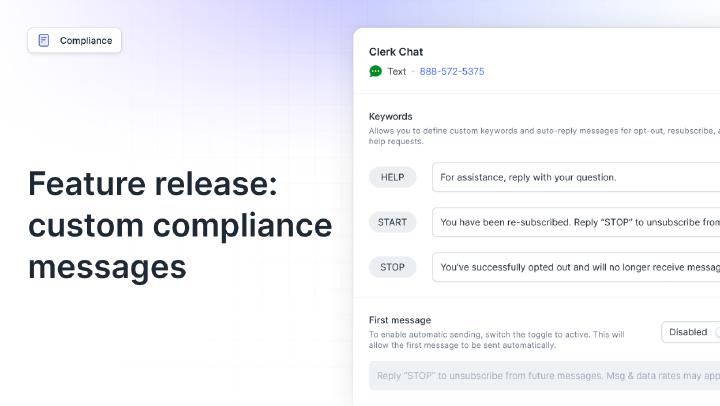What is Conversational AI? The Ultimate Introductory Guide
By Team Clerk Chat
- Published: June 12, 2024
Conversational AI is more than just a trending topic – it could be the future of customer service. With the ability to mimic human interactions, streamline the customer journey, and deliver support on a 24/7 basis across a range of channels, conversational intelligence is a transformative tool.
Already, companies in every industry are experimenting with conversational AI in their two-way messaging strategies, marketing campaigns and more.
But what exactly is conversational AI? How does it work, and what are the use cases that can deliver the biggest benefits for your organization?
Here’s everything you need to know about the evolving conversation AI landscape.
What is Conversational AI?
Conversational AI (or conversational artificial intelligence) is a technology that allows human beings to interact with bots and computer systems. Made possible by natural language processing and understanding, this form of AI allows computers to understand and respond to human language.
If you’ve ever interacted with a smart speaker or assistant (like Alexa), or had a conversation with the various AI chatbots used by businesses to automate customer service, you’ve already encountered conversational AI.
Today, this type of artificial intelligence is enabling businesses across industries to deliver personalized, engaging and efficient experiences across multiple channels.
Alongside building chatbots, companies can enable AI SMS conversations, voice-based discussions with AI systems, and more.
Conversational AI VS Generative AI
Notably, conversational AI isn’t exactly the same as another form of trending AI available today: Generative AI. Both types of intelligence support interactions between humans and computer systems. However, generative AI is a broader category of AI software, primarily used for creating new content, such as videos, code, images, and text.
The purpose of conversational AI is to allow bots to understand and process human speech, and contribute to a natural conversation. Most of the time, this technology is used to enhance and automate things like AI-powered SMS customer service, or chatbot-based self-service.
The goal of generative AI is to create new, unique content for things like marketing campaigns, product development, and so on.
While most forms of conversational AI are “generative”, not all generative AI is conversational. For instance, image generation tools like DALL-E are generative, but they don’t have “conversations” with users.
Learn how to create conversations that convert - with SMS
Book a free, personalized product tour to see our user-friendly interface, discover our most-used features, and get answers to your questions
How Conversational AI Works
So, how does conversational artificial intelligence work? Though the functionality of a conversational AI tool can vary, all of these solutions rely on a combination of machine learning and natural language processing, understanding, and generation capabilities.
- Machine learning: The sub-field of artificial intelligence made up of various algorithms, data sets, and features that can continuously improve themselves based on experience. As the system access more data, the AI system becomes more effective at processing and recognizing patterns.
- Natural language processing: The technology which allows computer systems to analyze language using machine learning. This technology allows bots to transform “unstructured” data into a format that can be read by a computer.
- Natural language understanding: NLU ensures that conversational AI models can not just process language, but also understand user intent and context. Using machine learning, bots can discern context, and effectively respond to input.
- Natural language generation: After a system processes a user’s input, it can formulate a coherent and appropriate response using natural language generation. Because the system can understand the intent and context behind a query, companies can go beyond simple “auto reply text messages” to deliver more personalized, relevant responses.
The Benefits of Conversational AI Technology
Conversation AI tools are becoming increasingly crucial for businesses of all sizes. In fact, 72% of business leaders prioritize expanding AI and chatbots across the customer experience in the next 12 months. On a broad scale, conversational AI helps companies to deliver better customer experiences. In fact, Clerk Chat’s AI agents have been used across sales, support, and marketing teams.
With this technology, businesses can deliver 24/7 support to customers. More importantly, they can personalize the experience for each customer. On top of that, conversational AI helps businesses reduce costs, automate processes, and even access more valuable data, it can:
- Automate customer service tasks: Conversational AI is excellent at enhancing the self-service experience for customers. It can quickly address customer concerns and queries at any time, on a range of channels.
- Reduce costs: Studies show that companies could save up to $8 billion each year, just by implementing the right AI bots. Conversational AI can reduce the need for companies to hire additional employees to deliver customer support around the clock.
- Improve business insights: Conversational AI tools can gather and analyze data from thousands of interactions. They can help businesses to better understand their customers and their needs, create comprehensive journey maps and user profiles, and ensure companies make decisions that improve customer loyalty and satisfaction rates.
- Increase revenue: Implemented as part of a marketing and sales strategy, conversational AI can help to increase revenue. It can allow companies to send personalized text messages and offers to customers throughout the consumer journey, increasing conversions. It can also help to boost customer retention rates, increasing customer lifetime value.
- Enhance accessibility: Conversational AI can improve accessibility for customers with disabilities, rapidly converting text into audio and vice versa. It can also be used to support customers from different locations around the world. Most bots are multi-lingual, ensuring companies can effectively communicate with any customer.


How to Get Started with Conversational AI
Launching a conversational messaging or conversational AI strategy isn’t as complex as it seems. Modern platforms and solutions like Clerk Chat ensure businesses don’t need extensive coding or programming knowledge to build their own AI strategies.
Here are the three steps you’ll need to take to get started with conversation AI.
1. Define Your Goals and Use Cases
The first step in implementing a conversational AI initiative is deciding what you want to accomplish with your new technology. Companies can use this tech for a range of purposes.
Plus, you can implement conversational artificial intelligence into a range of platforms and communication channels. For example, if your goal is to improve customer service, you might use conversational SMS solutions to give your customers another fast-paced and convenient way to access support and troubleshoot common problems 24/7.
If you’re hoping to collect data to help with business decision-making, you might use a combination of automated text messages and conversational AI to issue surveys, request feedback from customers, or gather data about customer preferences and demands.
You can even use conversational AI to facilitate transactions. For instance, a bot could communicate with customers about a new offer or promotion, then process a purchase or booking request.
2. Choose the Right Platform
Once you have a clear vision for what you want to accomplish with your conversational AI technology, the next step is choosing a platform that allows you to build and customize your own bot. The right solution for you will depend on your specific goals and communication channels.
For instance, if you’re using conversational AI to improve your texting strategy for customer service, sales and marketing, you’ll need a platform that works with SMS, like Clerk Chat. If you’re looking to compare multiple solutions, be sure to explore our comprehensive guide on the top conversational AI platforms to find the one that best fits your needs. Other things to consider when you’re comparing platforms include:
- Integrations: Alongside SMS integrations or integrations with other communication channels (like voice), your technology should be able to integrate with other crucial systems, like your Customer Relationship Management (CRM) software.
- Ease of use: The easier your platform is to use, the simpler it will be to implement and scale your AI strategy. Look for a solution that includes customizable SMS templates for customer service, and easy-to-implement automation workflows.
- Security and compliance: Make sure the platform you use features solutions for preserving security and compliance, such as two-factor authentication access controls.
- Scalability: A highly scalable platform will allow you to transform your AI strategy over time. It might be worth looking for a platform that combines conversational AI tools with SMS transactional messages or campaign automation.
- Reports and analytics: Reporting and analytical tools will help you monitor the impact of your conversational AI strategies, and gather insights on your target audience. This should help you to optimize your campaigns going forward.
3. Create, Launch, and Monitor your Solution
Finally, once you have the right platform, you’ll be able to build and customize your conversational AI strategy to suit your needs. For most companies it may make sense to start with simple workflows, like using conversational AI to provide 24/7 support to customers on a single channel.
Over time, you’ll be able to expand on your initiative, adding new channels into the mix, experimenting with proactive customer service and selling strategies, and automating more marketing campaigns. As you build on your strategy, make sure you monitor the results of your campaigns, pay attention to feedback, and make data-driven decisions for growth.
Just because your conversational AI tools can learn and improve automatically, doesn’t mean you shouldn’t be constantly looking for ways to improve the technology.
Invest in the Future of Conversational AI with Clerk Chat
Already, conversational AI is having a transformative effect on customer experiences in virtually every industry. As the technology grows smarter, with more advanced algorithms and solutions, the potential for businesses will be astronomical.
If you’re ready to optimize your sales and marketing efforts, deliver more personalized and relevant service to customers, and unlock greater levels of efficiency, now’s the time to invest in conversational AI. With Clerk Chat, any company can combine powerful SMS marketing and customer support strategies, with an intuitive and customizable conversational AI solution.
Our state-of-the-art Clerk Assistant will help you drive revenue, reduce operational costs, and enhance your brand’s reputation.
What are you waiting for? Join the conversational AI revolution with Clerk Chat today.
In this article:
Ready to use your business number for text messaging?
Thousands of businesses are already experiencing the power of conversational messaging through SMS. Join us. Free trial and paid tiers available.
Get Started#Subscribe
Get product updates in your inbox
Tutorials, features, and Clerk Chat news delivered straight to you.




